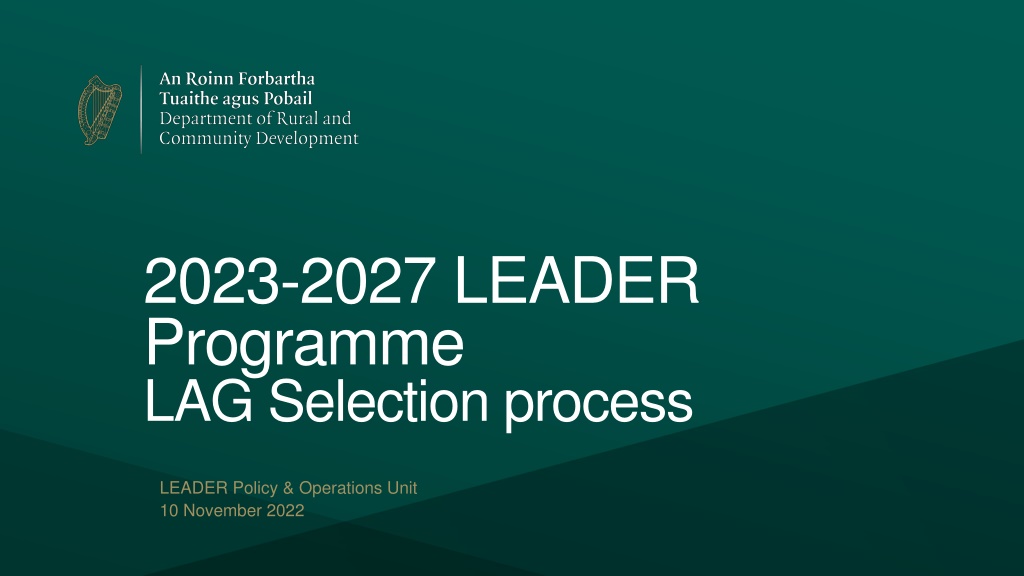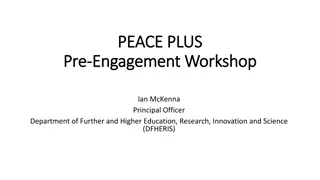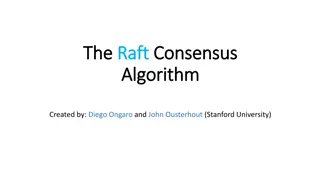Understanding LEADER Programme and Sub-Regional Areas in Ireland
LEADER Programme in Ireland is a key element of the Rural Development Policy 2021-2025, focusing on bottom-up, community-led approaches for rural development. It is delivered across 28 sub-regional areas, excluding main cities, through Local Action Groups implementing Local Development Strategies. Sub-regional areas align with county boundaries, with specific considerations for offshore islands. The programme aims to promote employment, growth, gender equality, social inclusion, and local development in rural areas.
Download Presentation

Please find below an Image/Link to download the presentation.
The content on the website is provided AS IS for your information and personal use only. It may not be sold, licensed, or shared on other websites without obtaining consent from the author. Download presentation by click this link. If you encounter any issues during the download, it is possible that the publisher has removed the file from their server.
E N D
Presentation Transcript
2023-2027 LEADER Programme LAG Selection process LEADER Policy & Operations Unit 10 November 2022
What is LEADER? Key element of Our Rural Future - Rural Development Policy 2021-2025 LEADER approach is based on 7 specific principles Bottom-up approach Community-led Local Development (CLLD) Area based local development strategies, Integrated & Multi-sectoral strategies Local Partnerships, Networking Innovation, Cooperation Co-funded under the European Agricultural Fund for Rural Development (EAFRD) through Ireland s CAP Strategic Plan Must contribute to the CSP, in particular specific objective set out in Article 6(1)(h) EU Regulation 2021/2115 to promote employment, growth, gender equality, social inclusion and local development in rural areas, including bio-economy and sustainable forestry.
How will LEADER be delivered in Ireland? Programme will be delivered across 28 sub-regional areas All areas covered with exception of 5 main cities Delivered on the ground by Local Action Groups Actions for implementation of the programme outlined in the Local Development Strategy(LDS)
What is a sub-regional area? Sub-regional areas are aligned with the county boundaries All rural areas covered outside the 5 main cities of Dublin, Cork, Limerick, Waterford & Galway Exception to this in County Cork 3 sub-regional areas of North, South and West maintained Rural areas within the county of Dublin grouped to form a single sub-regional area Flexibility will be provided to allow submission of a LDS that covers Part of a sub-regional area or Multiple LDS to cover parts of multiple sub-regional areas Off shore islands Continue to be aligned with the relevant county sub-regional area structure Specific actions will be required of the LAG selected in sub-regional area that contains offshore islands Dedicated representative drawn from the Island community to form part of the LAG decision making body Specific actions in the LDS to address needs and challenges of the Island communities Ring-fenced budget to implement these actions
What is a Local Action Group(LAG)? Representatives of public and private local socioeconomic interest groups in which no single interest group controls the decision-making (EU Regulation 2021/1060, Article 31(2)(b)) Central to the formation of the LAG is partnership principle Membership would include Local non-governmental organisations, local development companies, development agencies, local community-based groups, marginalised communities, youth organisations, cultural bodies, sporting bodies, social movements, networks, and relevant public bodies Aim to achieve gender balance Each member holds equal status as decision-making member of the LAG
Role of the Local Action Group(LAG) Article 33 of EU Regulation 2021/1060 outlines roles of the LAG Responsible for designing and implementing the Local Development Strategy(LDS) Building capacity of local communities, supporting them in the development and implementation of their specific projects Drawing up selection criteria for supporting projects Preparing & publishing calls for project proposals Selecting projects for support and deciding on the level of support Monitoring progress on the achievement of the objectives of their LDS Evaluating the implementation of the LDS Responsible for promoting the LEADER programme in their area
What is a Local Development Strategy(LDS) This will be the focus of Stage 2 of the process Plan or strategy for your identified area Developed in consultation with communities and businesses in the area Bottom up approach to rural development CLLD All stakeholders should be involved in the development of the LDS Identifies assets of the area, looks at challenges and details the measures that will be implemented to improve the area LDS should be realistic reflection of how the available funding can be best used Guidance document outlines the broad themes that the LDS must focus on these are indicative and not mandatory but actions in the LDS must contribute to Specific Objective 6(1)(h) Further information on developing a LDS will be provided when Stage 2 of the selection process commences
LEADER Themes to promote employment, growth, gender equality, social inclusion and local development in rural areas, including bio-economy and sustainable forestry . Specific Objective 6(1)(h) CSP Regulation Economic Development & Job Creation The Green Economy; Agricultural Diversification (e.g. glamping on farm); Rural Tourism & Recreation; Enterprise Development; Rural Food Production; Social, Community & Cooperative Enterprises. Rural Infrastructure & Social Inclusion Rural Infrastructure Accessible Services Optimising Digital Connectivity Rural Youth
LEADER Themes contd. Sustainable Development of Rural Environment and Climate Change Mitigation and Adaptation Sustainable Development of Rural Environment Climate Change Capacity Building Climate Change Mitigation and Adaption
Funding 250m funding available for the period 2021 2027 70m allocated under the Transitional LEADER Programme for 2021 and 2022 180m allocated for the period 2023 2027 How was 180m allocated? Minimum allocation of 3m to each sub-regional area This accounts for 84m (28 sub-regional areas County Cork has 3) Population density Population density of the area compared to the National average Level of Deprivation Resource Allocation Model Weighted towards rural areas and considered areas of low and medium deprivation Similar approach taken under the last programme with relevant population and deprivation figures updated to take account of the passage of time
Selection Process Stage 1 now open Expression of Interest by eligible groups to apply to be considered a Local Action Group (LAG) for new programme Guidance document on the process and application form available on the Department s website Application form must be submitted by email only to leader2327@drcd.gov.ie Closing date is 5.30pm on Friday 16thDecember 2022. Expect to be notifying successful applicants early in January 2023 Stage 2 Will open once Stage 1 concludes and successful applicants have been notified Development of LEADER strategies Six month period will be provided for submission of completed strategy Strategy can be submitted earlier if ready in areas where only one applicant was identified in Stage 1 Funding will be provided by the Department to all groups progressing to Stage 2 to assist with strategy development Independent Selection Committee with assess and select the strategies First LAGs must be operational by end August 2023
EOI Application form Sections 1, 2 and 3 deal with the sub-regional area Indicate the sub-regional area you are applying for Will your LDS cover all or part of that area If part of the area you need to indicate the district electoral divisions & geographical area in Km2 This information is necessary for distribution of funding & to identify if any areas are not covered Section 4: Please describe how the Community Led Local Development (CLLD) approach will be used in order to develop and deliver your proposed LDS Outline what engagement you will have within your proposed area to develop the LDS in Stage 2 and deliver on the actions
EOI Application form contd. Section 5: Composition of your LAG Outline how your LAG will meet the core principle of partnership Outline how LAG aims to achieve required representation from the various sectors with particular focus on young people and marginalised groups Section 6: Proposed actions to implement the LEADER programme in your area. Overview of the actions you propose to detail in your LDS These can be further expanded on in Stage 2 Section 7: Any additional information that you wish to include in support of your bid to develop and deliver an LDS in your sub-regional area
EOI Application form contd. Section 8: Level of funding sought to develop your proposed LDS and the basis for the calculation 2m in funding is available to assist with costs associated with developing the strategies Amount being sought will be considered and assessed for reasonableness of costs Simplified cost options basis 50% will be paid at the start of Stage 2, remainder at the conclusion of Stage 2 Not necessary to have your submitted LDS selected in order to receive preparatory support funding
Next Steps Closing date for receipt of completed EOIs is 5.30pm on Friday 16thDecember 2022 Questions asked here today or by email will be compiled into a Q&A document, will be available on Department s website Further Q&A documents will issue if required EOIs will be assessed for eligibility outcome known early in January Stage 2 will then open 6 month period First LAG to be operational August 2023 Any queries email leader2327@drcd.gov.ie























